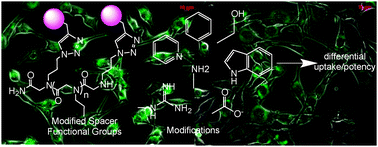Influencing uptake and localization of aminoglycoside-functionalized peptoids†
Abstract
The development of small-molecule therapeutics that target

a Department of Chemistry and The Center of Excellence in Bioinformatics and Life Sciences, University at Buffalo, The State University of New York, Natural Sciences Complex, Buffalo, USA
b
Department of Chemistry, The Scripps Research Institute, Scripps Florida, 130 Scripps Way #3A1, Jupiter, USA
E-mail:
disney@scripps.edu
The development of small-molecule therapeutics that target

 Please wait while we load your content...
Something went wrong. Try again?
Please wait while we load your content...
Something went wrong. Try again?
M. M. Lee, J. M. French and M. D. Disney, Mol. BioSyst., 2011, 7, 2441 DOI: 10.1039/C1MB05074E
To request permission to reproduce material from this article, please go to the Copyright Clearance Center request page.
If you are an author contributing to an RSC publication, you do not need to request permission provided correct acknowledgement is given.
If you are the author of this article, you do not need to request permission to reproduce figures and diagrams provided correct acknowledgement is given. If you want to reproduce the whole article in a third-party publication (excluding your thesis/dissertation for which permission is not required) please go to the Copyright Clearance Center request page.
Read more about how to correctly acknowledge RSC content.
 Fetching data from CrossRef.
Fetching data from CrossRef.
This may take some time to load.
Loading related content
